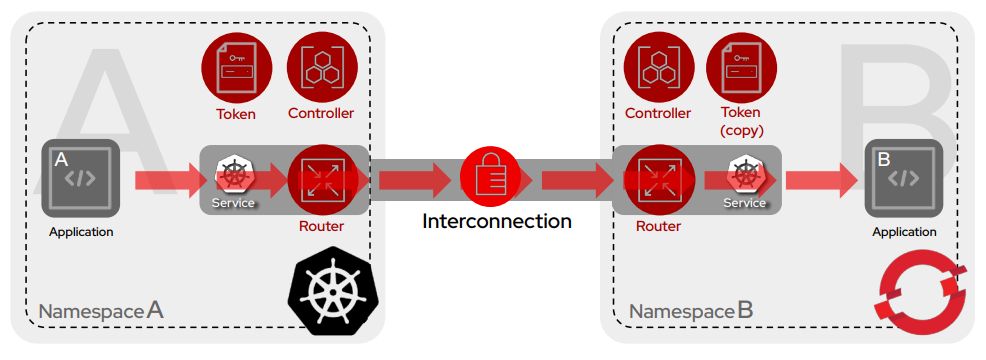Red Hat Service Interconnect
Build interconnected clouds with Red Hat
Interconnection is an important characteristic of distributed applications, especially across the hybrid cloud. It acts as the blood vessels connecting different parts of systems, which helps organizations to take advantage of distributed capabilities and deliver value to end users and a competitive edge in the marketplace. Red Hat Service Interconnect simplifies application connectivity by allowing anyone on the development team to create interconnections without elevated privileges.
Common challenges for building and using interconnections include:
Connecting services across a hybrid cloud environment: The need to interconnect different applications in different clusters (Red Hat® OpenShift® and public cloud Kubernetes offerings or other Kubernetes distributions) to one another or to other more traditional environments such as virtual machines (VMs) and bare-metal hosts safely and efficiently.
Integrate with applications and services that will never migrate to a cloud or a Kubernetes cluster: Applications often need to be connected with services that will not be moved to a cloud or Kubernetes environment such as relational databases. Often the costs of migration will not justify porting conventional applications, so a better approach is to interconnect the conventional workloads with modern, cloud-native applications or services.
Progressive migration of private datacenters to Red Hat OpenShift: Helps customers to migrate existing applications progressively from VMs or bare-metal hosts to Red Hat OpenShift while maintaining interconnections required for application execution.
Progressive migration of Kubernetes to Red Hat OpenShift or Red Hat OpenShift 3 to Red Hat OpenShift 4: Existing applications running on any Kubernetes environment can now be strategically migrated by interconnecting to a Red Hat OpenShift cluster and progressively moving applications across these environments. The same idea applies to applications running on Red Hat OpenShift 3 when the need exists to migrate to a newer Red Hat OpenShift 4 cluster progressively, while maintaining interconnections required for application execution.
Database replication across cloud environments: Allows protected interconnection between multiple distinct cloud providers, where each has its own database.
What is Red Hat Service Interconnect?
Red Hat Service Interconnect delivers a simple and portable way to interconnect safely between different environments, including a combination of Red Hat and non-Red Hat platforms. Using a simple command line without requiring elevated privileges, a team of developers can interconnect their development environment anywhere.
Unlike traditional solutions, Red Hat Service Interconnect works on top of any existing network topology and abstract them away for applications effectively. The result is the ability to make complex migrations to other environments more efficient, resulting in increased developer productivity, simplified networking overhead and ensuring applications can properly work in hybrid scenarios.
Features and benefits
Red Hat Service Interconnect is a cross-platform product that can be used in combination with Red Hat and non-Red Hat platforms in order to address hybrid and multicloud scenarios. This allows organizations to be more efficient, choosing where their applications run and how to interconnect between them safely and effectively.
By using the capability of smart routing, interconnections find an optimal path to endpoints with no additional configuration. This feature provides an extra level of flexibility to developer teams, avoiding extensive networking planning, regardless of the network topology or event, for IP versions such as IPv4 and IPv6.
The abstraction created by Red Hat Service Interconnect allows interconnections in hybrid scenarios to work uninterrupted. Organizations are now able to take advantage of different public and private environments without sacrificing security or reliability.
Simplified networking created by Red Hat Service Interconnect reduces the complexity, effort, and required resources for managing infrastructures across different environments as compared to traditional approaches such as virtual private networks (VPNs) and complex firewall rules. This can help organizations to optimize their IT resource allocation more effectively.
Table 1. Red Hat Service Interconnect features
Portable
Allows interconnections to move to other environments in order to ease complex migrations.
Simple
Command line without elevated privileges that anyone can interconnect environments and platforms more easily.
Protected
Interconnections use Mutual TLS encryption to not compromise your organization's infrastructure and data.
Hybrid
Any Kubernetes cluster, any VMs and bare-metal hosts can be interconnected—combined with both Red Hat and non-Red Hat products.
| Features | Description |
| Application layer abstraction |
Interconnections created are agnostic of the environment, IP versions (such as IPv4 and IPv6), and support portability for both applications and its associated networking configuration. Migrations of applications across environments and across the software life cycle can now be done without having to recreate the required networking. |
| Simple command-line interface | Provides a simple command-line interface (CLI) which can be used without elevated privileges by the development team in order to establish strong security-focused connections across environments. |
|
Mutual TLS encryption |
Interconnections created use mutual Transport Layer Security (TLS) in order to prevent unauthorized interconnections. Organizations now can operate more flexibly and more quickly while keeping your organization's infrastructure and data protected. |
| OpenShift operator | Using an OpenShift operator, platform engineers can deploy and manage interconnections between Kubernetes clusters, regardless of whether they are running on-premises, in a cloud or in other environments, pr oviding a unified and distributed application networking solution. |
To learn more visit Red Hat Service Interconnect
For application developers, try Red Hat Service Interconnect




